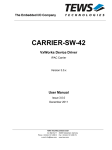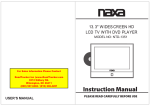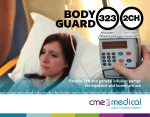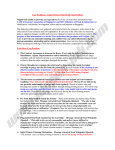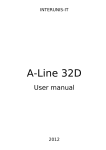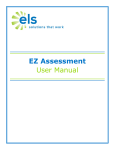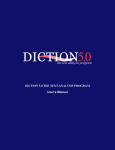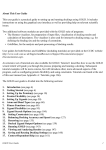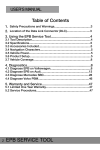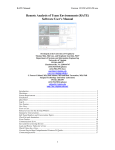Download M91-1039
Transcript
APPENDIX C :
GUIDELINES FOR INTERACTIVE SCORIN G
1. INTRODUCTIO N
This document, although fairly extensive, is not intended to give you a n
exhaustive list of "do's" and "don'ts" about doing the interactive scoring of th e
templates . Instead, it presents you with guidelines and some examples, in order to
imbue you with the spirit of the enterprise . It is up to you to carefully consider you r
reasons before judging mismatching responses to be "completely" or "partially "
correct .
Thus, you should attempt to set aside a substantial amount of time to do the
interactive scoring and should plan to do it when you are rested and can be a s
objective as humanly possible about your system's performance . Please refer to the
file key-tst2-notes for examples of decisions NOSC made in preparing the answer key .
If you have any doubt whether any given system
response deserves to be judge d
completely/partially correct, count it incorrect .
2. SETTING UP THE SCORING PROGRAM IN INTERACTIVE MODE
You must use the latest official version of the scoring program together with th e
latest slotconfig .el file . You are not permitted to make any modifications of your ow n
to the scoring software or the files it uses, except to define the pathnames in th e
config .el file for the files that it reads in .
The configuration (config .el) files supplied with the test package set the :query verbose option on, which places the scoring program in interactive mode . (See MU C
Scoring System User's Manual, section 5 .2 .) The only feature of the interactiv e
scoring that you are *not* permitted to take advantage of is the option to change a
key or response template! This feature is controlled by the :disable-edit option, which
is set on in the config .el files supplied in the test package and should not be modified .
Although there may be errors in the key templates, you are not permitted to fi x
them, as we do not have sufficient time to make the corrections known to all sites .
Score your system under the assumption that the answer key is correct, make note o f
any perceived errors in the key, and email them to NOSC along with your results . I f
there is sufficient evidence that errors were made that affect the scores obtained, a
new key will be prepared after the conference, and sites will be given th e
opportunity to rescore their system responses . The new scores will replace the ol d
ones as the official results .
Included among your options for interactive scoring is the manual
realignmen t
of response templates with key templates (see section 3 .2 .1
below and section 4 .7 o f
User's Manual) . If you are not already comfortable using the interactive scorin g
features of the scoring program, take some time to practice on some texts in th e
training set before you attempt to do the scoring for the test set . Also be sure to rea d
the document on test procedures carefully re saving your history buffer to a file fo r
C-I
use in other scoring sessions required for completing the test procedure . Referenc e
to key-tst2-notes while you are doing the interactive scoring might help yo u
understand the key better and give you ideas on cases when alternative fillers migh t
be justified .
3. SCORING MISMATCHED SLOT FILLER S
3 .1 BY TYPE OF FILL
These subsections deal in turn with string fills, set fills, and other types of fills .
Following that is a section concerning cross-reference tags .
3 .1 .1 STRING FILL S
Slots requiring string fills are slots 5, 6, 8, and 11 . In the case of a mismatch o n
fillers for these slots, the scoring program will permit you to score the response a s
fully correct, partially correct, or incorrec t
3 .1 .1 .1 FULLY CORREC T
NOSC has attempted to provide a choice of good string options for each string slot .
If you get a mismatch, before you score a filler fully correct you should conside r
carefully whether your system's filler is both complete enough and precise enoug h
to show that the system found exactly the right information .
The most likely situation where "fully correct" would be justified is in a cas e
where the system or the key includes "nonessential modifiers" such as articles ,
quantifiers, and adjectivals for nationalities (e .g ., SALVADORAN) .
EXAMPLE (slot 11) : RESPONSE "THE 3 PEASANTS "
KEY
"PEASANTS "
In filling the key templates, such nonessential modifiers were generally include d
in slot 5 (since there are no slots specifically for the number and nationality of th e
perpetrators) . They were generally excluded from fillers for the other string slots ,
unless they seemed to be part of a proper name (e .g . THE EXTRADITABLES) .
"Fully correct" is also warranted if the system response contains more modifyin g
words and phrases than the answer key, as long as all the modifiers are modifiers o f
the noun phrase . However, in most cases the answer key should already contai n
options such as these .
EXAMPLE (slot 11) : RESPONSE "OLD PEASANTS WHO WERE WITNESSES "
KEY
"PEASANTS" / "OLD PEASANTS "
Finally, if your system does not generate an escape (backslash) character in fron t
of the inner double quote marks of a filler that is surrounded by double doubl e
quotes, you may score the system response as completely correct if it would otherwis e
match the key .
EXAMPLE :
RESPONSE "'TOO
KEY
'1 "FOO\"" / "FOO "
C—2
3 .1 .1 .2 PARTIALLY CORREC T
You may score a filler partially correct, but not fully correct, if your system goe s
overboard and includes adjuncts in the response string that aren't part of the desire d
noun phrase .
EXAMPLE (slot 11) : RESPONSE "THE 3 PEASANTS, WHICH TH E
GOVERNMENT ADMITTED WAS A MISTAKE "
KEY
"PEASANTS "
Scoring a filler partially correct is also appropriate in cases where the ke y
contains a proper name (in the most complete form found in the text) and th e
response contains only part of the name (i .e ., uses an incomplete form found in th e
text) .
EXAMPLE (slot 11) : RESPONSE TORRES" ("BODYGUARD" )
KEY
"ALBERTO ROBERTO TORRES" ("BODYGUARD" )
3 .1 .2 SET FILL S
Slots requiring set fills are slots 3, 4, 7, 10, 13, 14, 15, 17, and 18 . (Slot 16, th e
LOCATION slot, is not treated by the scoring program as having set fills .) In the cas e
of a mismatch on fillers for these slots, the scoring program will not permit you t o
score them as fully correct . (But see section 3 .1 .4 below re an exception . Also, se e
3 .2 .7 and 3 .2 .15 for information concerning automatic assignment of partial credit b y
the scoring program . )
NOSC has attempted to offer all the possible alternative correct fillers as options i n
the key ; however, scoring a filler partially correct may be justified in certain cases .
See the appropriate subsections of section 3 .2 below .
3 .1 .3 OTHER TYPES OF FILL S
Slots requiring other types of fills are slots 1, 2, 9, 12, and 16 . In the case of a
mismatch on fillers for these slots, the scoring program will permit you to score th e
fillers as fully correct, partially correct, or incorrect .
(But see section 3 .1 .4 below re
an exception .
Also, see 3 .2 .16 for information concerning automatic assignment o f
partial credit by the scoring program . )
NOSC has attempted to offer all the possible alternative correct fillers as options i n
the key ; however, scoring a filler completely or partially correct may be justified i n
certain cases .
See the appropriate subsections of section 3 .2 below .
3 .1 .4 FILLS THAT INCLUDE CROSS-REFERENCE TAG S
3 .1 .4 .1 FULLY CORREC T
The scoring program permits you to score a slot as fully correct in the case of a
mismatch on the slots listed in 3 .1 .2 and 3 .1 .3 above where the only mismatch is on a
cross-reference tag . In such cases, you may score the entire filler as fully correc t
only if the filler of the slot indicated by the cross-reference tag was also scored a s
fully correct .
C—3
3 .1 .4 .2 PARTIALLY CORREC T
If the non-tag portion of the filler is not judged completely correct (by th e
criteria found in other sections of this set of guidelines), the best you can do is t o
judge the entire filler partially correct . If the non-tag portion is *completely *
correct and the tag is either missing or incorrect, it is appropriate to score the entir e
filler partially correct .
Scoring the entire filler partially correct may also be done if the non-tag portio n
of the filler is judged *partially* correct and the tag is either missing or incorrect .
In this case, however, you must re-read the text and judge the partial correctness o f
the non-tag portion with respect to the way the text refers to the *KEY'S* tag, no t
the system response tag . In other words, you must be able to show that the syste m
got the non-tag portion partially correct for the right reason . (Note that thi s
guideline is based on the assumption that some systems might intentionally, no t
accidentally, generate a correct filler and, for independent reasons, give it a n
incorrect tag . )
EXAMPLE (slot 7) : RESPONSE SUSPECTED OR ACCUSED : "RIGHT-WINGERS "
KEY
REPORTED AS FACT: "LEFT-WINGERS "
(where SUSPECTED OR ACCUSED has been judged partially correct with respec t
to its *CORRECT* intended referent, "LEFT-WINGERS", i .e ., on the basis of
presuming that the whole system response was SUSPECTED OR ACCUSED : "LEFTWINGERS" rather than SUSPECTED OR ACCUSED : "RIGHT-WINGERS" )
3 .1 .4 .3 INCORREC T
If the non-tag portion of the filler is judged incorrect, then the entire filler mus t
be judged incorrect, even if the tag portion is correct or partially correct .
3 .2 BY INDIVIDUAL SLO T
3 .2 .1 Slot 1 -- TEMPLATE I D
The guidelines here concern the manual realignment of templates in the cas e
where the automatic template mapping facility provided by the scoring progra m
fails to identify the optimal mapping between the set of response templates for a
message and the set of key templates for that message . Guidelines are needed becaus e
it is possible for the user to elect not to map a response template to any key templat e
at all, i .e ., to map a response template to NIL and a key template to NIL rather tha n
mapping the templates to each other. The user may wish to do this in cases where th e
match between the response and the key is so poor and the number of mismatchin g
fillers so large that the user would rather penalize the system's recall an d
overgeneration (by mapping to NIL) than penalize the system's precision .
However, to ensure the validity of the performance measures and to ensur e
comparability among the systems being evaluated, it is important that this option no t
be overused . The basic rule is that the user must permit a mapping between a
response template and a key template if there is a full or partial match on th e
incident type . (The condition concerning a partial match covers the two basi c
situations described in section 3 .2 .3 below .) If there is no match on the incident type ,
manually mapping to NIL is allowed, at the discretion of the user .
C-4
3 .2 .2 Slot 2 -- DATE OF INCIDEN T
FULLY CORRECT OR PARTIALLY CORRECT :
System response is close to the key's date or range of dates (if the date i s
difficult to calculate) . In the example below, the system's response may be judge d
fully correct, since the system has calculated a more precise date than what wa s
expected by the key .
EXAMPLE :
"X OCCURRED ON AUGUST 30, 1989 ,
AND Y OCCURRED A WEEK LATER "
RESPONSE
(for Y) 06 SEP 89
KEY
(for Y) 30 AUG 89 - 15 SEP 89
(where the latter date is the date of the article )
TEXT
PARTIALLY CORRECT :
1.
System response is part of the date contained in the key (either if an inciden t
occurred between two dates or if the filler in the key is a default value, i .e . ,
consists of a range with the date from the message dateline as the uppe r
anchor) .
EXAMPLES :
2.
RESPONSE
KEY
26 AUG 89
25 AUG 89-26 AUG 8 9
RESPONSE
KEY
26 AUG 89
26 AUG 89 (default fill)
RESPONSE
KEY
25 AUG 89
-26 AUG 89 (default fill)
System response is a default-looking value (as described above)
and the ke y
is a bounded range that has the date of the message dateline as the uppe r
anchor .
EXAMPLE :
RESPONSE - 26 AUG 89 (default-looking fill )
KEY
25 AUG 89 - 26 AUG 8 9
NOTE : The system response should be judged INCORRECT when the response is a
default-looking value (as described above) and the key does not have the defaul t
anchor date as its value or, in the case of a range, as the upper anchor .
EXAMPLES :
RESPONSE - 26 AUG 89 (default-looking
KEY
25 AUG 89
RESPONSE
KEY
fill )
- 26 AUG 89 (default-looking fill)
24 AUG 89-25 AUG 89
3 .2 .3 Slot 3 -- TYPE OF INCIDEN T
FULLY CORRECT :
Mismatch not allowed to be scored fully correct .
C—5
PARTIALLY CORRECT :
The number of cases where it is justifiable to score this slot partially correc t
should be limited, especially for situations other than the following :
1.
System response is the correct incident type, except that ATTEMPTED o r
THREAT is missing .
2.
System response is ATTACK instead of the specific incident type found in th e
key .
3 .2 .4 Slot 4 -- CATEGORY OF INCIDEN T
FULLY CORRECT:
Mismatch not allowed to be scored fully correct .
PARTIALLY CORRECT :
Since there are only two set fills for this slot, there should be few instances wher e
a mismatch should result in scoring the filler partially correct .
3 .2 .5 Slot 5 -- PERPETRATOR : ID OF INDIV(S )
FULLY CORRECT:
See section 3 .1 .1 .1 .
PARTIALLY CORRECT :
See section 3 .1 .1 .2 .
3 .2 .6 Slot 6 -- PERPETRATOR : ID OF ORG(S )
FULLY CORRECT:
1.
In general, the guidelines in section 3 .1 .1 .1 do not apply to this slot, since thi s
slot is intended to be filled only with proper names . However, the ter m
"proper names" is not completely defined, especially with respect to th e
expected fillers in the case of STATE-SPONSORED TERRORISM . You have more
leeway to score fillers as fully correct in such cases .
EXAMPLE :
2.
RESPONSE "POLICE "
KEY
"SECRET POLICE "
Response string includes both acronym and expansion (where they appea r
juxtaposed in the text) instead of just one or the other .
EXAMPLE :
RESPONSE "ARMY OF NATIONAL LIBERATION (ELN) "
KEY
"ARMY OF NATIONAL LIBERATION" / "ELN "
PARTIALLY CORRECT :
C-•6
The number of cases where it is justifiable to score this slot partially correc t
should be very limited .
3 .2 .7 Slot 7 -- PERPETRATOR : CONFIDENC E
FULLY CORRECT:
Mismatch not allowed to be scored fully correct .
PARTIALLY CORRECT :
The number of cases where it is justifiable to score this slot partially correc t
should be limited, especially for situations other than the following :
Syste m
determines a a lesser confidence than actually warranted : POSSIBLE (syste m
response) instead of CLAIMED OR ADMITTED, SUSPECTED OR ACCUSED, or SUSPECTED O R
ACCUSED BY AUTHORITIES (key) . Even in these cases, there has to be some stron g
justification based on e .g . a difference of opinion as to how a human would interpre t
the text in order to justify partial correctness .
NOTE :
The scoring program will automatically score the system response partiall y
correct in the case where the system generates SUSPECTED OR ACCUSED instead o f
SUSPECTED OR ACCUSED BY AUTHORITIES .
3 .2 .8 Slot 8 -- PHYSICAL TARGET : ID(S )
FULLY CORRECT :
See section 3 .1 .1 .1 .
PARTIALLY CORRECT :
1.
See section 3 .1 .1 .2 .
2.
Response string is good enough to corroborate categorization made in TYP E
slot (assuming system response for TYPE slot is correct) . Note that the strin g
in the key may sometimes not be good enough by this criterion ; in such case s
you must decide for yourself whether the system response is as good as h e
filler in the key is .
3 .2 .9 Slot 9 -- PHYSICAL TARGET : TOTAL NU M
PARTIALLY CORRECT :
System response is PLURAL instead of a specific number in the key, in case s
where filler had to be summed up, especially where approximate numbers are given ,
e .g ., "some 20 power stations and over 30 banks" .
3 .2 .10 Slot 10 -- PHYSICAL TARGET : TYPE(S )
FULLY CORRECT :
Mismatch not allowed to be scored fully correct .
C—7
PARTIALLY CORRECT :
The number of cases where it is justifiable to score this slot partially correc t
should be very limited .
3 .2 .11 Slot 11 -- HUMAN TARGET : ID(S )
FULLY CORRECT:
1.
See section 3 .1 .1 .1 .
2.
Response is a correct proper name, but person's title/role is included as part o f
name, rather than in parentheses following the name .
EXAMPLE :
RESPONSE "MR . XYZ"
KEY
"XYZ" ("MR ." )
PARTIALLY CORRECT :
1.
2.
See section 3 .1 .1 .2 .
Response is a correct proper name, but person's title/role is missing o r
incorrect .
EXAMPLE :
RESPONSE "XYZ "
KEY
"XYZ" ("MR . " )
3 .2 .12 Slot 12 -- HUMAN TARGET : TOTAL NU M
PARTIALLY CORRECT :
System response is PLURAL instead of a specific number in the key, in case s
where filler had to be summed up, especially where approximate numbers are given ,
e .g ., "some 20 employees and over 30 other people" .
3 .2 .13 Slot 13 -- HUMAN TARGET : TYPE(S )
FULLY CORRECT :
Mismatch not allowed to be scored fully correct .
PARTIALLY CORRECT :
The number of cases where it is justifiable to score this slot partially correc t
should be limited, especially for situations other than the following, where "partiall y
correct" may be justified if the text is particularly unclear :
1.
System response is GOVERNMENT OFFICIAL or ACTIVE MILITARY ; key ha s
FORMER GOVERNMENT OFFICIAL or FORMER ACTIVE MILITARY.
2.
System response is POLITICAL FIGURE; key has GOVERNMENT OFFICIAL .
3 .2.14 Slot 14 -- TARGET : FOREIGN NATION(S )
C-8
FULLY CORRECT :
Mismatch not allowed to be scored fully correct .
PARTIALLY CORRECT :
The number of cases where it is justifiable to score this slot partially correc t
should be limited, especially for situations other than the following : Syste m
responds with correct country, but in a form that doesn't match the set list .
EXAMPLE :
RESPONSE U .S .
KEY
UNITED STATE S
3 .2 .15 Slot 15 -- INSTRUMENT : TYPE(S )
FULLY CORRECT:
Mismatch not allowed to be scored fully correct .
PARTIALLY CORRECT :
The number of cases where it is justifiable to score this slot partially correc t
should be extremely limited, except in those cases that are handled automatically b y
the scoring program, i .e ., where the system response is a set list item that is a
superset of the filler in the key, as determined by the shallow hierarchy o f
instrument types provided in the task documentation . .
EXAMPLE :
RESPONSE GUN
KEY
MACHINE GUN
3 .2 .16 Slot 16 -- LOCATION OF INCIDEN T
PARTIALLY CORRECT :
1.
The key expresses a range between two known locations, and the syste m
response contains only one location .
EXAMPLE :
2.
RESPONSE COLOMBIA : MEDELLIN (CITY)
KEY
COLOMBIA : MEDELLIN (CITY) - CALI (CITY)
Response has correct country, but in a form that doesn't match the set list .
EXAMPLE :
RESPONSE U .S .
KEY
UNITED STATES
The scoring program will automatically score a response partiall y
NOTE :
specific place or an incorrec t
correct when it contains correct country but no
specific place .
EXAMPLES :
RESPONSE COLOMBIA
COLOMBIA : MEDELLIN (CITY)
KEY
C—9
RESPONSE COLOMBIA : CALI (CITY)
KEY
COLOMBIA : ANTIOQUTA (DEPARTMENT) :
MEDELLIN (CITY)
3 .2 .17 Slot 17 -- EFFECT ON PHYSICAL TARGET(S )
FULLY CORRECT :
Mismatch not allowed to be scored fully correct .
PARTIALLY CORRECT :
The number of cases where it is justifiable to score this slot partially correc t
should be limited, especially for situations other than the following : Syste m
response correctly indicates that damage was done but under- or overestimate s
amount of damage .
EXAMPLE :
RESPONSE SOME DAMAGE
KEY
DESTROYED
3 .2 .18 Slot 18 -- EFFECT ON HUMAN TARGET(S )
FULLY CORRECT:
Mismatch not allowed to be scored fully correct .
PARTIALLY CORRECT :
The number of cases where it is justifiable to score this slot partially correc t
should be limited, especially for situations other than the following :
System respons e
contains less information than the key .
EXAMPLE :
RESPONSE NO INJUR Y
KEY
NO INJURY OR DEATH










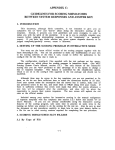

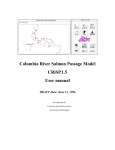
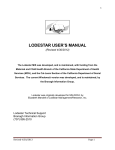
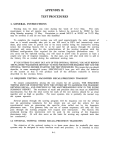
![[incr tsdb()]](http://vs1.manualzilla.com/store/data/005780303_1-7064634619abc733efac654e2a82e90d-150x150.png)
